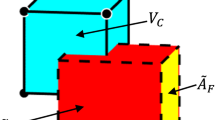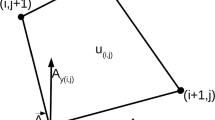Abstract
We highlighted the flexibility of using unstructured mesh together with the local refinement by a resistivity model with complicated topography. The effect of topography is emphasized. Based on this, we calculated a specific class of layered models and found that the accuracy is not always satisfactory by utilizing the standard approach. As an improvement, we employed the layered earth as the reference model to calculate the wavenumbers. The comparison demonstrates that the accuracy is considerably improved by using this enhanced approach.
Similar content being viewed by others
References Cited
Coggon, J. H., 1971. Electromagnetic and Electrical Modeling by the Finite Element Method. Geophysics, 36(1): 132–155
Dey, A., Morrison, H. F., 1979. Resistivity Modelling for Arbitrarily Shaped Two-Dimensional Structures. Geophysical Prospecting, 27(1): 106–136
Erdogan, E., Demirci, I., Candansayar, M. E., 2008. Incorporating Topography into 2D Resistivity Modeling Using Finite-Element and Finite-Difference Approaches. Geophysics, 73(3): F135–F142
Fox, R. C., Hohmann, G. W., Killpack, T. J., et al., 1980. Topographic Effects in Resistivity and Induced-Polarization Surveys. Geophysics, 45(1): 75–93
Frey, P. J., 2001. MEDIT—An Interactive Mesh Visualization Software. INRIA Technical Report 0253. http://www-rocq.inria.fr/gamma/medit/medit.html. Accessed November 26, 2007
Hvozdara, M., Kaikkonen, P., 1996. The Boundary Integral Solution of a DC Geoelectric Problem for a 2-D Body Embedded in a Two-Layered Earth. Journal of Applied Geophysics, 34(3): 169–186
Lesur, V., Cuer, M., Straub, A., 1999. 2-D and 3-D Interpretation of Electrical Tomography Measurements, Part 1: The Forward Problem. Geophysics, 64(2): 386–395
Li, J. M., 2005. Geoelectric Field and Electric Prospecting. Geological Publishing House, Beijing. 473 (in Chinese)
Li, Y. G., Spitzer, K., 2002. Three-Dimensional DC Resistivity Forward Modelling Using Finite Elements in Comparison with Finite-Difference Solutions. Geophysical Journal International, 151(3): 924–934
Mufti, I. R., 1976. Finite-Difference Resistivity Modeling for Arbitrarily Shaped Two-Dimensional Structures. Geophysics, 41(1): 62–78
Mundry, E., 1984. Geoelectrical Model Calculations for Two-Dimensional Resistivity Distributions. Geophysical Prospecting, 32(1): 124–131
Pidlisecky, A., Knight, R., 2008. FW2_5D: A MATLAB 2.5-D Electrical Resistivity Modeling Code. Computers & Geosciences, 34(12): 1645–1654
Ruan, B. Y., 2001. 2-D Electrical Modeling due to a Current Point by FEM with Variation of Conductivity within Each Triangular Element. Guangxi Sciences, 8(1): 1–3 (in Chinese with English Abstract)
Scalicky, T., 1996. LASPack Reference Manual. http://www.netlib.org. Accessed September 9, 2007
Shewchuk, J. R., 1996. Triangle: A Two-Dimensional Quality Mesh Generator and Delaunay Triangulator. WACG, 1st Workshop on Applied Computational Geometry. 124–133. http://www.cs.cmu.edu/~quake/triangle.html. Accessed March 12, 2007
Snyder, D. D., 1976. A Method for Modeling the Resistivity and IP Response of Two-Dimensional Bodies. Geophysics, 41(5): 997–1015
Tang, J. T., Wang, F. Y., 2008. 2.5-D Direct Current Resistivity Simulation Based on the Unstructured Mesh. Computing Techniques for Geophysical and Geochemical Exploration, 30(5): 413–418 (in Chinese)
Tang, J. T., Wang, F. Y., Ren Z. Y., 2010. 2.5-D DC Resistivity Modeling by Adaptive Finite-Element Method with Unstructured Triangulation. Chinese J. Geophys., 53(3): 708–716 (in Chinese with English Abstract)
Tsourlos, P. I., Szymanski, J. E., Tsokas, G. N., 1999. The Effect of Terrain Topography on Commonly Used Resistivity Arrays. Geophysics, 64(5): 1357–1363
Xiong, B., Ruan, B. Y., 2002. A Numerical Simulation of 2-D Geoelectric Section with Biquadratic Change of Potential for Resistivity Sounding by the Finite Element Method. Chinese Journal of Geophysics, 45(2): 285–295 (in Chinese)
Xu, S. Z., Duan, B. C., Zhang, D. H., 2000. Selection of the Wavenumbers K Using an Optimization Method for the Inverse Fourier Transform in 2.5D Electrical Modeling. Geophysical Prospecting, 48(5): 789–796
Xu, S. Z., Zhao, S. K., Ni, Y., 1998. A Boundary Element Method for 2-D DC Resistivity Modeling with a Point Current Source. Geophysics, 63(2): 399–404
Zienkiewicz, O. C., Taylor, R. L., 2000. The Finite Element Method, Volume I: The Basic. Fifth Edition. Butterworth-Heinemann, Woburn, MA. 347
Zienkiewicz, O. C., Zhu, J. Z., 1992a. The Superconvergent Patch Recovery and a Posteriori Error Estimates. Part 1: the Tecovery Technique. International Journal for Numerical Methods in Engineering, 33(7): 1331–1364
Zienkiewicz, O. C., Zhu, J. Z., 1992b. The Superconvergent Patch Recovery and a Posteriori Error Estimates. Part 2: Error Estimates and Adaptivity. International Journal for Numerical Methods in Engineering, 33(7): 1365–1382
Author information
Authors and Affiliations
Corresponding author
Additional information
This study was supported by the National High Technology Research and Development Program of China (863 Program) (No. 2007AA06Z134), and the National Natural Science Fundation of China (No. 40874072).
Rights and permissions
About this article
Cite this article
Tang, J., Wang, F., Xiao, X. et al. 2.5-D DC resistivity modeling considering flexibility and accuracy. J. Earth Sci. 22, 124–130 (2011). https://doi.org/10.1007/s12583-011-0163-z
Received:
Accepted:
Published:
Issue Date:
DOI: https://doi.org/10.1007/s12583-011-0163-z




